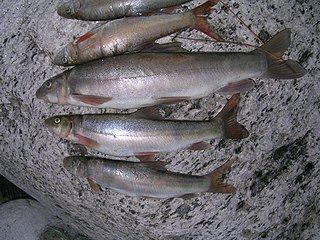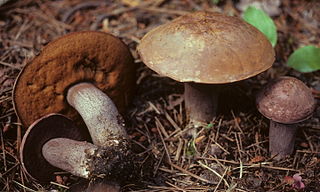
Magnolia is a large genus of about 210 to 340 flowering plant species in the subfamily Magnolioideae of the family Magnoliaceae. It is named after French botanist Pierre Magnol.

The Polyporaceae are a family of poroid fungi belonging to the Basidiomycota. The flesh of their fruit bodies varies from soft to very tough. Most members of this family have their hymenium in vertical pores on the underside of the caps, but some of them have gills or gill-like structures. Many species are brackets, but others have a definite stipe – for example, Polyporus badius.

Metarhizium robertsii – formerly known as M. anisopliae, and even earlier as Entomophthora anisopliae (basionym) – is a fungus that grows naturally in soils throughout the world and causes disease in various insects by acting as a parasitoid. Ilya I. Mechnikov named it after the insect species from which it was originally isolated – the beetle Anisoplia austriaca. It is a mitosporic fungus with asexual reproduction, which was formerly classified in the form class Hyphomycetes of the phylum Deuteromycota.

Schizothorax is a genus of cyprinid fish found in southern and western China, through northern South Asia (Himalaya) and Central Asia, to Iran, with a single species, S. prophylax, in Turkey. They are primarily found in highland rivers, streams and lakes, although a few species occur in lower-lying locations, like Lake Balkhash and lakes of the Sistan Basin. Their scientific name means "cloven-breast", from Ancient Greek schízeïn (σχίζειν) 'to cleave' and thórax (θώραξ) 'breast-plate'. The western species are typically referred to as marinkas from their Russian name marinka (маринка), while the eastern species are usually called snowtrout. Although they do resemble trouts in habitus this is merely due to convergent evolution and they are by no means closely related apart from both being Teleostei: Cyprinids are in the teleost superorder Ostariophysi, while trouts are in the superorder Protacanthopterygii. Their ancestors must thus have diverged as early as the Triassic, more than 200 million years ago.

Triplophysa is a genus of fish in the family Nemacheilidae found mainly in and around the Qinghai-Tibet Plateau in China. Currently, the genus is a mixed assemblage of species. Some lineages have been identified and treated as subgenera, but as Wikipedia follows Fishbase for fish species all but Hedinichthys have been treated as subgenera in Wikipedia, although Kottelat in his revision of the loaches did recognise them as valid. FishBase, however, includes these in Triplophysa without specifying subgenera and treats the names given by Kottelat as synonyms.

Phanerochaete is a genus of crust fungi in the family Phanerochaetaceae.

Metarhizium is a genus of entomopathogenic fungi in the Clavicipitaceae family. With the advent of genetic profiling, placing these fungi in proper taxa has now become possible. Most turn out to be the asexual forms (anamorphs) of fungi in the phylum Ascomycota, including Metacordyceps spp.

The Meruliaceae are a family of fungi in the order Polyporales. According to a 2008 estimate, the family contains 47 genera and 420 species. As of April 2018, Index Fungorum accepts 645 species in the family.

Cunninghamella is a genus of fungi in the order Mucorales, and the family Cunninghamellaceae. The genus was circumscribed by French mycologist Alphonse Louis Paul Matruchot in Ann. Mycol. Vol.1 on page 47 in 1903.
Hjortstamia is a genus of poroid fungi in the family Phanerochaetaceae. It was circumscribed by French mycologists Jacques Boidin and Gilles Liège in 2003.

Ceriporia is a widely distributed genus of crust fungi.
Maublancia is a genus of fungi in the Microthyriaceae family.
Lenzitopsis is a genus of fungi in the family Thelephoraceae. This genus contains two species, the type Lenzitopsis oxycedri and L. daii, described as new to science in 2012.

Pteris ensiformis, the slender brake, silver lace fern, sword brake fern, or slender brake fern, is a plant species of the genus Pteris in the family Pteridaceae. It is found in Asia and the Pacific.

Sutorius is a genus of fungi in the family Boletaceae. Its type species is the widely distributed Sutorius eximius. The Asian Boletus obscureumbrinus, found in Japan and China, was described by Japanese mycologist Tsuguo Hongo in 1968, moved to genus Sutorius in 2016, but then reclassified into genus Neoboletus in 2019. The Australian Sutorius australiensis and the southern Chinese Sutorius subrufus also belong to the genus.
André Pierre Jules Maublanc was a French mycologist and plant pathologist.
Metarhizium rileyi is a species of entomopathogenic fungus in the family Clavicipitaceae; there is extensive literature under its synonym Nomuraea rileyi.
Aschersonia is a genus of fungi in the order Hypocreales and family Clavicipitaceae.
Metarhizium pinghaense is a species of entomopathogenic fungus in the family Clavicipitaceae. Some authorities have it as a synonym of Metarhizium anisopliae. DNA studies show that it is a good species, with strong bootstrap support.

Massalongia is a genus of lichen-forming fungi in the family Massalongiaceae. It has four species. The genus was circumscribed by German lichenologist Gustav Wilhelm Körber in 1855, with M. carnosa assigned as the type species.











